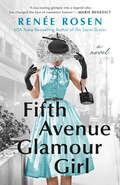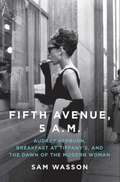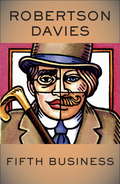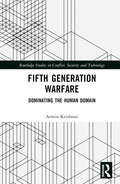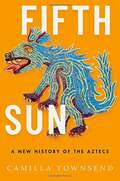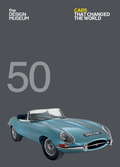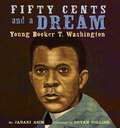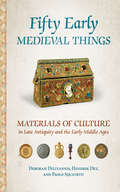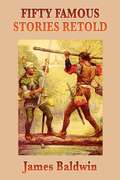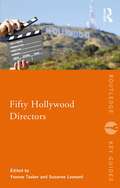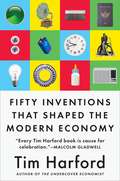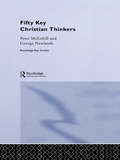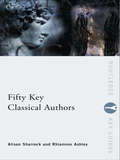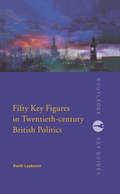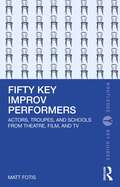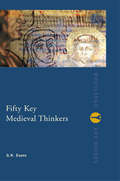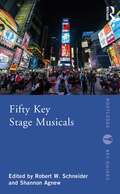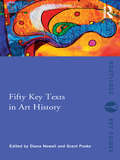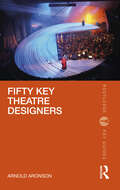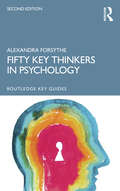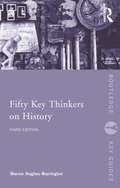- Table View
- List View
Fifth Avenue Glamour Girl
by Renée RosenIt&’s 1938, and a young woman selling face cream out of a New York City beauty parlor is determined to prove she can have it all. Her name is Estée Lauder, and she&’s about to take the world by storm, in this dazzling new novel from the USA Today bestselling author of The Social Graces and Park Avenue Summer.In New York City, you can disappear into the crowd. At least that&’s what Gloria Downing desperately hopes as she tries to reinvent herself after a devastating family scandal. She&’s ready for a total life makeover and a friend she can lean on—and into her path walks a young, idealistic woman named Estée. Their chance encounter will change Gloria&’s life forever.Estée dreams of success and becoming a household name like Elizabeth Arden, Helena Rubinstein, and Revlon. Before Gloria knows it, she is swept up in her new friend&’s mission and while Estée rolls up her sleeves, Gloria begins to discover her own talents. After landing a job at Saks Fifth Avenue, New York&’s finest luxury department store, Gloria finds her voice, which proves instrumental in opening doors for Estée&’s insatiable ambitions.But in a world unaccustomed to women with power, they&’ll each have to pay the price that comes with daring to live life on their own terms and refusing to back down.
Fifth Avenue, 5 A.M.
by Sam WassonAudrey Hepburn is an icon like no other, yet the image many of us have of Audrey-dainty, immaculate-is anything but true to life. Here, for the first time, Sam Wasson presents the woman behind the little black dress that rocked the nation in 1961. The first complete account of the making of Breakfast at Tiffany's, Fifth Avenue, 5 A.M. reveals little-known facts about the cinema classic: Truman Capote desperately wanted Marilyn Monroe for the leading role; director Blake Edwards filmed multiple endings; Hepburn herself felt very conflicted about balancing the roles of mother and movie star. With a colorful cast of characters including Truman Capote, Edith Head, Givenchy, "Moon River" composer Henry Mancini, and, of course, Hepburn herself, Wasson immerses us in the America of the late fifties before Woodstock and birth control, when a not-so-virginal girl by the name of Holly Golightly raised eyebrows across the country, changing fashion, film, and sex for good. Indeed, cultural touchstones like Sex and the City owe a debt of gratitude to Breakfast at Tiffany's. In this meticulously researched gem of a book, Wasson delivers us from the penthouses of the Upper East Side to the pools of Beverly Hills, presenting Breakfast at Tiffany's as we have never seen it before-through the eyes of those who made it. Written with delicious prose and considerable wit, Fifth Avenue, 5 A.M. shines new light on a beloved film and its incomparable star.
Fifth Avenue, 5 A.M.: Audrey Hepburn, Breakfast at Tiffany's, and the Dawn of the Modern Woman
by Sam WassonNow in paperback in time for the 60th anniversary of the film version Breakfast at Tiffany’s— the New York Times bestseller and first-ever complete account of Audrey Hepburn and the making of the film that Janet Maslin called “a bonbon of a book filled with delightful anecdotes”With a cast of characters that includes Audrey Hepburn, Truman Capote, and Gerald Clarke, this book offers a slice of social history seen through the lens of one of America’s most iconic films The images of Breakfast at Tiffany’s are branded into our collective memory: we can see Audrey Hepburn stepping out of that cab on the corner of 57th and 5th, and we can picture her again with George Peppard, huddled in an alleyway and wrapped in a kiss, as the rain pours down around them. Those moments are as familiar to us as any in whole the history of movies, but few of us know that that ending was not the film’s original ending. In fact, it was only one of two endings the filmmakers shot—and it almost didn’t make it in. The reasons why have to do with Tiffany’s cutting-edge take on sex in the city, namely, when to show it, and how to do it, without getting caught. If Truman Capote had it his way, his beloved Marilyn Monroe would have been cast as Holly, but crafty executives knew that she’d have the censors on red alert. So they went for Audrey. But would she go for them? Frightened at the prospect of playing a part so far beyond her accepted range—not to mention the part of call girl—Audrey turned inside out worrying if she should take her agent’s advice and accept the role. What would people think? America’s princess playing a New York bad girl? It seemed just too far…The First Little Black Dress is the first ever complete account of the making of Breakfast at Tiffany’s. Drawing upon countless interviews with those involved in the film’s production, from actors to producer Richard Shepherd to Gerald Clarke, Capote’s biographer, Wasson brings us inside the world and indeed inside the mind of one of America’s greatest cinematic icons.Wasson immerses us in the America of the late fifties, before Woodstock and birth control, when a not-so-virginal girl by the name of Holly Golightly raised eyebrows across the nation, changing fashion, film, and sex, for good. But that was the easy part. Getting Audrey there—and getting the right people behind her—that was the tough part.With the heart of a novelist and the eye of a critic, Wasson delivers us from the penthouses of the Upper East Side to the pools of Beverly Hills, from script to screen and from rehearsal to “Action!” The First Little Black Dress presents Breakfast at Tiffany’s as we have never seen it before—through the eyes of those who made it.
Fifth Business (Deptford Trilogy #1)
by Robertson DaviesThe first novel in Davies's celebrated "Deptford Trilogy" introduces Ramsay, a man who returns from World War I decorated with the Victoria Cross who is destined to be caught in a no man's land where memory, history, and myth collide.
Fifth Generation Warfare: Dominating the Human Domain (Routledge Studies in Conflict, Security and Technology)
by Armin KrishnanThis book outlines the concept of Fifth Generation Warfare (5GW) and demonstrates its relevance for understanding contemporary conflicts.Non-kinetic modes of attack and war waged by groups or non-state actors at the societal level has been termed 5GW. This book discusses the theory of generational warfare and explores the key ideas of 5GW, such as secrecy, the manipulation of proxies, the manipulation of identity and culture (including disinformation and big data), and the use of psychological warfare. These techniques are used to achieve strategic objectives, such as inducing desired behaviour and controlling human terrain, without resorting to overt war or overt violence. The text expands the debate on 5GW by exploring emerging technologies and how they could be used for maliciously shaping human society and even for maliciously changing the genetic makeup of a population for the purpose of unprecedented social control. The work closes with comments on the possibility of a Sixth Generation of Warfare, which targets technical systems to possibly collapse a society through strategic sabotage. Overall, the book demonstrates the relevance of 5GW for understanding contemporary conflicts, from the Arab Spring to the war in Ukraine, in terms of the need for dominating the human domain.This book will be of interest to students of security and technology, defence studies and International Relations.
Fifth Sun: A New History of the Aztecs
by Camilla TownsendIn November 1519, Hernando Cortés walked along a causeway leading to the capital of the Aztec kingdom and came face to face with Moctezuma. That story--and the story of what happened afterwards--has been told many times, but always following the narrative offered by the Spaniards. After all, we have been taught, it was the Europeans who held the pens. But the Native Americans were intrigued by the Roman alphabet and, unbeknownst to the newcomers, they used it to write detailed histories in their own language of Nahuatl. Until recently, these sources remained obscure, only partially translated, and rarely consulted by scholars. For the first time, in Fifth Sun, the history of the Aztecs is offered in all its complexity based solely on the texts written by the indigenous people themselves. Camilla Townsend presents an accessible and humanized depiction of these native Mexicans, rather than seeing them as the exotic, bloody figures of European stereotypes. The conquest, in this work, is neither an apocalyptic moment, nor an origin story launching Mexicans into existence. The Mexica people had a history of their own long before the Europeans arrived and did not simply capitulate to Spanish culture and colonization. Instead, they realigned their political allegiances, accommodated new obligations, adopted new technologies, and endured. This engaging revisionist history of the Aztecs, told through their own words, explores the experience of a once-powerful people facing the trauma of conquest and finding ways to survive, offering an empathetic interpretation for experts and non-specialists alike.
Fifty Cars That Changed the World: Design Museum Fifty (Design Museum Fifty Ser.)
by Design Museum Enterprise LimitedEverything around us is designed and the word 'design' has become part of our everyday experience. But how much do we know about it? Fifty Cars That Changed the World imparts that knowledge listing the top 50 cars that have made a substantial impact in the world of British design today. From the1908 Ford Model T to the 1998 smart car, each entry offers a short appraisal to explore what has made their iconic status to give them a special place in design history.
Fifty Cars that Changed the World: Design Museum Fifty (Design Museum Fifty)
by Design Museum Enterprise LimitedEverything around us is designed and the word 'design' has become part of our everyday experience. But how much do we know about it? Fifty Cars That Changed the World imparts that knowledge listing the top 50 cars that have made a substantial impact in the world of British design today. From the1908 Ford Model T to the 1998 smart car, each entry offers a short appraisal to explore what has made their iconic status to give them a special place in design history.
Fifty Cents and a Dream
by Jabari Asim Bryan CollierBooker dreamed of making friends with words, setting free the secrets that lived in books. Born into slavery, young Booker T. Washington could only dream of learning to read and write. After emancipation, Booker began a five-hundred-mile journey, mostly on foot, to Hampton Institute, taking his first of many steps towards a college degree. When he arrived, he had just fifty cents in his pocket and a dream about to come true. The young slave who once waited outside of the schoolhouse would one day become a legendary educator of freedmen. Award-winning artist Bryan Collier captures the hardship and the spirit of one of the most inspiring figures in American history, bringing to life Booker T. Washington's journey to learn, to read, and to realize a dream.
Fifty Classic British Films, 1932-1982: A Pictorial Record
by Anthony Slide200 striking photographs, in-depth commentaries, plot synposes, contemporary reviews, and more -- about 50 British classics from yesterday and today. Preface. Text. Alphabetical list of films. Bibliography.
Fifty Early Medieval Things: Materials of Culture in Late Antiquity and the Early Middle Ages
by Paolo Squatriti Deborah Deliyannis Hendrik DeyFifty Early Medieval Things introduces readers to the material culture of late antique and early medieval Europe, north Africa, and western Asia. Ranging from Iran to Ireland and from Sweden to Tunisia, Deborah Deliyannis, Hendrik Dey, and Paolo Squatriti present fifty objects—artifacts, structures, and archaeological features—created between the fourth and eleventh centuries, an ostensibly "Dark Age" whose cultural richness and complexity is often underappreciated. Each thing introduces important themes in the social, political, cultural, religious, and economic history of the postclassical era. Some of the things, like a simple ard (plow) unearthed in Germany, illustrate changing cultural and technological horizons in the immediate aftermath of Rome's collapse; others, like the Arabic coin found in a Viking burial mound, indicate the interconnectedness of cultures in this period. Objects such as the Book of Kells and the palace-city of Anjar in present-day Jordan represent significant artistic and cultural achievements; more quotidian items (a bone comb, an oil lamp, a handful of chestnuts) belong to the material culture of everyday life. In their thing-by-thing descriptions, the authors connect each object to both specific local conditions and to the broader influences that shaped the first millennium AD, and also explore their use in modern scholarly interpretations, with suggestions for further reading. Lavishly illustrated and engagingly written, Fifty Early Medieval Things demonstrates how to read objects in ways that make the distant past understandable and approachable.
Fifty Famous Stories Retold
by James BaldwinJames Baldwin has collected fifty wonderful stories, including Robin Hood, William Tell, King Alfred and Julius Caesar. Your child will be delighted to hear or read these, and will not only be entertained, but will learn about history and folklore. These stories will also help lay the foundation for broader literary studies.
Fifty Hollywood Directors (Routledge Key Guides)
by Yvonne Tasker Suzanne LeonardFifty Hollywood Directors introduces the most important, iconic and influential filmmakers who worked in Hollywood between the end of the silent period and the birth of the blockbuster. By exploring the historical, cultural and technological contexts in which each director was working, this book traces the formative period in commercial cinema when directors went from pioneers to industry heavyweights. Each entry discusses a director’s practices and body of work and features a brief biography and suggestions for further reading. Entries include: Frank Capra Cecil B DeMille John Ford Alfred Hitchcock Fritz Lang Orson Welles DW Griffith King Vidor This is an indispensible guide for anyone interested in film history, Hollywood and the development of the role of the director.
Fifty Inventions That Shaped the Modern Economy
by Tim HarfordA lively history seen through the fifty inventions that shaped it most profoundly, by the bestselling author of The Undercover Economist and Messy. Who thought up paper money? What was the secret element that made the Gutenberg printing press possible? And what is the connection between The Da Vinci Code and the collapse of Lehman Brothers? Fifty Inventions That Shaped the Modern Economy paints an epic picture of change in an intimate way by telling the stories of the tools, people, and ideas that had far-reaching consequences for all of us. From the plough to artificial intelligence, from Gillette’s disposable razor to IKEA’s Billy bookcase, bestselling author and Financial Times columnist Tim Harford recounts each invention’s own curious, surprising, and memorable story. Invention by invention, Harford reflects on how we got here and where we might go next. He lays bare often unexpected connections: how the bar code undermined family corner stores, and why the gramophone widened inequality. In the process, he introduces characters who developed some of these inventions, profited from them, and were ruined by them, as he traces the principles that helped explain their transformative effects. The result is a wise and witty book of history, economics, and biography.
Fifty Key Christian Thinkers (Routledge Key Guides)
by George Newlands Peter McEnhillFifty Key Christian Thinkers provides both valuable information and stimulating debate on the lives and work of fifty of the most important Christian theologians. This guide provides an overview of Christian theology from the emergence of the faith 2000 years ago to the present day. Among the figures profiled in this accessible guide are:* St Paul * Barth * Aquinas * Boethius* Niebuhr * Calvin* Luther * Feuerbach* Kierkegaard * Origen
Fifty Key Classical Authors (Routledge Key Guides)
by Alison Sharrock Rhiannon AshleyA chronological guide to influential Greek and Roman writers, Fifty Key Classical Authors is an invaluable introduction to the literature, philosophy and history of the ancient world. Including essays on Sappho, Polybius and Lucan, as well as on major figures such as Homer, Plato, Catullus and Cicero, this book is a vital tool for all students of classical civilization.
Fifty Key Figures in Twentieth Century British Politics (Routledge Key Guides)
by Keith LaybornThis guidebook provides a complete overview of the lives and influence of fifty major figures in modern British political history. Reflecting the changes within British society and politics over the past century, the entries chart the development of key contemporary issues such as women's rights, immigration and the emergence of New Labour. Figures covered include:* Winston Churchill* Tony Blair* Emmeline Pankhurst* David Lloyd George* Margaret Thatcher* John Maynard Keynes* Enoch Powell* Barbara CastleWith cross-referenced entries and helpful suggestions for further reading, this book is an essential guide for all those with an interest in understanding the dominating issues of modern British politics.
Fifty Key Improv Performers: Actors, Troupes, and Schools from Theatre, Film, and TV (Routledge Key Guides)
by Matt FotisFifty Key Improv Performers highlights the history, development, and impact of improvisational theatre by highlighting not just key performers, but institutions, training centers, and movements to demonstrate the ways improv has shaped contemporary performance both onstage and onscreen. The book features the luminaries of improv, like Viola Spolin, Keith Johnstone, and Mick Napier, while also featuring many of the less well‑known figures in improvisation who have fundamentally changed the way we make and view comedy – people like Susan Messing, Jonathan Pitts, Robert Gravel, and Yvon Leduc. Due to improv’s highly collaborative nature, the book features many of the art form’s most important theatres and groups, such as The Second City, TJ & Dave, and Oui Be Negroes. While the book focuses on the development of improvisation in the United States, it features several entries about the development of improv around the globe. Students of Improvisational Theatre, History of Comedy, and Performance Studies, as well as practitioners of comedy, will benefit from the wide expanse of performers, groups, and institutions throughout the book.
Fifty Key Medieval Thinkers (Routledge Key Guides)
by G.R. EvansFocussing on individuals whose ideas shaped intellectual life between 400 and 1500, Fifty Key Medieval Thinkers is an accessible introduction to those religious, philosophical and political concepts central to the medieval worldview. Including such diverse figures as Bede and Wyclif, each entry presents a biographical outline, a list of works and a summary of their main theories, alongside suggestions for further reading. Chronologically arranged, and with an introductory essay which presents important themes in context, this volume is an invaluable reference tool for all students of Medieval Europe.
Fifty Key Stage Musicals (Routledge Key Guides)
by Robert W. SchneiderThis volume in the Routledge Key Guides series provides a round-up of the fifty musicals whose creations were seminal in altering the landscape of musical theater discourse in the English-speaking world. Each entry summarises a show, including a full synopsis, discussion of the creators' process, show's critical reception, and its impact on the landscape of musical theater. This is the ideal primer for students of musical theater – its performance, history, and place in the modern theatrical world – as well as fans and lovers of musicals.
Fifty Key Texts in Art History (Routledge Key Guides)
by Diana Newall and Grant PookeFifty Key Texts in Art History is an anthology of critical commentaries selected from the classical period to the late modern. It explores some of the central and emerging themes, issues and debates within Art History as an increasingly expansive and globalised discipline. It features an international range of contributors , including art historians, artists, curators and gallerists. Arranged chronologically, each entry includes a bibliography for further reading and a key word index for easy reference. Text selections range across issues including artistic value, cultural identity, modernism, gender, psychoanalysis, photographic theory, poststructuralism and postcolonialism. Rozsika Parker and Griselda Pollock Old Mistresses, Women, Art & Ideology (1981) Victor Burgin’s The End of Art Theory: Criticism and Postmodernity (1986) Homi Bhabha The Location of Culture: Hybridity, Liminal Spaces and Borders (1994) Geeta Kapur When was Modernism in Indian Art? (1995) Judith Butler's Gender Trouble (1999) Georges Didi Huberman Confronting Images. Questioning the Ends of a Certain History of Art (2004)
Fifty Key Theatre Designers (Routledge Key Guides)
by Arnold AronsonFifty Key Theatre Designers looks at the history of theatrical scenography by examining the work and contributions of fifty ground-breaking set, costume, lighting, and projection designers since the Renaissance. Developments of scenic design are traced from the introduction of perspective painting to create illusionistic scenery in Renaissance Italy to the use of digital projection in the twenty-first century. The book also discusses important landmarks in the evolution of costume and lighting design, as well as the introduction of film and video technology to stage design. A broad range of work is explored, including opera, dance, Broadway and West End commercial theatre, avant-garde performance, and even Olympic spectacles. Each chapter features one designer, including basic biographical information and a discussion of that artist’s style, aesthetics, and contributions. Designers covered include Sebastiano Serlio, Ferdinando Bibiena, Richard Wagner, Adolphe Appia, and Edward Gordon Craig, amongst many other notable individuals. Each chapter also includes references to other significant designers with similar aesthetics or who made similarly important contributions to the development of that aspect of scenography. This book is ideal for undergraduates and graduates of scenography, theatrical design, and theatre history.
Fifty Key Thinkers in Psychology (Routledge Key Guides)
by Noel Sheehy Alexandra ForsytheFifty Key Thinkers in Psychology introduces the life, thought and work of some of the most influential figures who have shaped and developed modern psychology. It features accessibly written and fully cross-referenced entries on such figures as: Sigmund Freud, Noam Chomsky, Carl Jung, Ivan Pavlov, Jean Piaget, Anne Anastasi, Konrad Lorenz, Hans Eysenck and William James. This fascinating and informative guide is an invaluable resource for those studying, working in, or who simply want to find out more about psychology.
Fifty Key Thinkers in Psychology (Routledge Key Guides)
by Alexandra ForsytheThe new edition of Fifty Key Thinkers in Psychology introduces the life, thought, work and impact of some of the most influential figures who have shaped and developed modern psychology, considering a more diverse history of the discipline. The revised text includes new biographies, histories, and overviews of the work from scientists and scholars such as Alfred Alder, Isabel Briggs Myers, Katherine Cook Briggs and Karen Horney, as well as major re-writes of the works of Freud, Binet and Jung, and some of the more controversial characters such as Charles Galton and Hans Eysenck. Exploring the often overlooked but significant contributions of black, Jewish, and Eastern scholars to the discipline, this new edition looks to address the historically imbalanced focus of particular key thinkers and begin unpicking the impact that race and gender had on the direction and advancement of the field. The book covers the black psychology movement from George Herman Candy to Mamie Phipps Clark, and Kenneth Bancroft Clark, the enormous contribution of Chinese psychologist Jing Qicheng, and some of the many great psychologists whose families were part of the waves of Jewish emigration to the United States escaping oppression, persecution and economic hardship, including Walter Mischel, Cary Cooper and Daniel Kahneman. This fascinating and informative guide is an invaluable resource for those studying, working in, or who simply want to find out more about psychology, suitable for both students and the lay reader alike.
Fifty Key Thinkers on History (Routledge Key Guides)
by Marnie Hughes-WarringtonFifty Key Thinkers on History is an essential guide to the most influential historians, theorists and philosophers of history. The entries offer comprehensive coverage of the long history of historiography ranging from ancient China, Greece and Rome, through the Middle Ages to the contemporary world. This third edition has been updated throughout and features new entries on Machiavelli, Ranajit Guha, William McNeil and Niall Ferguson. Other thinkers who are introduced include: Herodotus Bede Ibn Khaldun E. H. Carr Fernand Braudel Eric Hobsbawm Michel Foucault Edward Gibbon Each clear and concise essay offers a brief biographical introduction; a summary and discussion of each thinker’s approach to history and how others have engaged with it; a list of their major works and a list of resources for further study.
